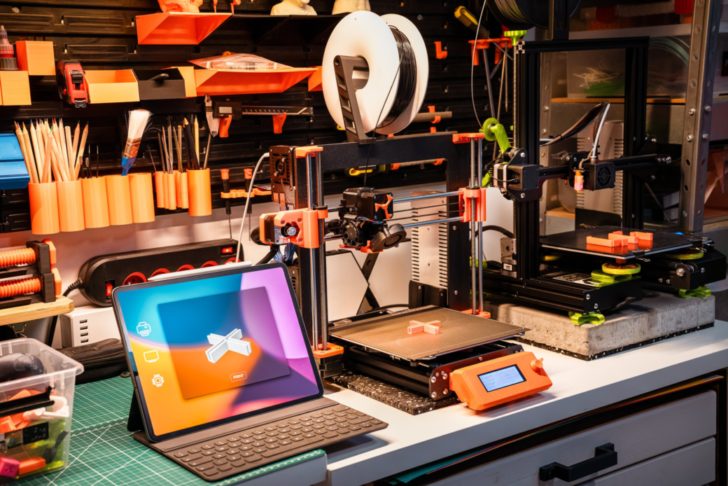Have you ever marvelled at the intricate designs created by 3D printers? The secret behind the magic lies in the versatile STL format. This powerful file format plays a crucial role in bringing your creative ideas to life, transforming them from mere concepts to tangible objects. Are you ready to delve into the fascinating world of STL files and unlock their full potential?
In this blog post, we will explore the ins and outs of the stl format, shedding light on their origins, key components, and various applications in 3D printing. As we journey through the world of STL files, we will compare ASCII and binary formats, discuss the process of creating and editing stl format files, and even touch upon alternative file formats that offer new possibilities for 3D printing enthusiasts. Let’s dive in!
Table of Contents
Key Takeaways
Understanding STL Format is essential for taking advantage of its capabilities in 3D printing.
The key components of STL files include facets, triangle vertices and normal vectors which define the surface geometry.
Alternatives to STL format such as OBJ, PLY and the emerging 3MF offer additional features but come with drawbacks.
Understanding STL Format: The Basics

A thorough comprehension of the basic structure and purpose of STL files is vital to appreciate their capabilities. STL, which stands for “Stereolithography” or “Standard Tessellation Language,” also known as the “standard triangle language,” is a file format that encodes the surface geometry of a 3D object using triangular tessellation. Originally created by the Albert Consulting Group for 3D Systems in 1987, STL files were designed to facilitate the production of scale models for rapid prototyping.
Over time, the STL format has become the most common file format for 3D printing, thanks to its compatibility with virtually all 3D printers and its ability to easily create and edit 3D models. With an extensive range of STL files available for download, including the option to download free stl files, the possibilities for 3D printing enthusiasts are virtually endless.
What is an STL File?
Essentially, an STL file depicts the surface geometry of a 3D object through triangular tessellation, while omitting information about color, texture, or material properties. The file consists of a series of interconnected triangles that define the surface geometry of the 3D object. This structure allows STL files to convert a 3D model into a language that a 3D printer can interpret, making it an essential component of the 3D printing process.
However, the simplicity of STL files does come with some limitations. Because they only store surface geometry data, STL files are unable to represent complex shapes or textures accurately. Additionally, the format does not store metadata, making it difficult to edit intricate models without the use of specialized software.
Despite these limitations, the STL format remains a popular choice for 3D printing enthusiasts due to its widespread support and ease of use.
The History of STL Format
The STL format has its roots in the early days of 3D printing when it was created by the Albert Consulting Group for 3D Systems in 1987. Its initial purpose was to enable the production of scale models for rapid prototyping, which was a groundbreaking development at the time.
Since then, the STL file format has evolved and adapted to become the go-to file format for 3D printing enthusiasts around the world, offering a versatile and widely supported solution for creating and editing 3D models.
Key Components of STL Files
After gaining a fundamental understanding of STL files and their historical background, let’s further explore the integral elements that constitute these files. The key components of STL files consist of facets, triangle vertices, and normal vectors. These elements work together to define the surface geometry of a 3D object, ensuring an accurate representation of the object’s shape and structure.
The roles of facets, triangle vertices, and normal vectors in STL files are pivotal and understanding them helps to appreciate their contribution to the format’s versatility and functionality. In the following sections, we will explore each of these components in greater detail, shedding light on their significance in the realm of 3D printing.
Facets and Triangle Vertices
Facets are the individual flat surfaces that compose a 3D object. In the context of triangles, a facet refers to a single triangle that forms part of the overall shape. Triangle vertices, on the other hand, are the points where the edges of a triangle meet, defining the corners of the triangle and determining its shape and size. Together, facets and triangle vertices are utilized to depict the surface of a 3D object in STL files, with each facet consisting of a small triangle.
The use of facets and triangle vertices in STL files offers several advantages.
They accurately portray the surface of a 3D object, making them ideal for representing complex shapes and structures.
However, this level of precision can result in larger file sizes, as each facet requires more data to be stored than a larger polygon.
Despite this drawback, the benefits of using facets and triangle vertices in STL files make them an essential component of the format.
Normal Vectors
Normal vectors play a crucial role in defining the orientation of each facet in STL files. As direction vectors that determine the orientation of a triangle, normal vectors ensure that the 3D object’s surface is accurately represented in the file.
By adhering to the vertex rule and ensuring that adjacent triangles share two vertices, the normal vectors guarantee a consistent orientation throughout the model, resulting in a more accurate representation of the object’s surface geometry.
ASCII vs. Binary STL Files
Working with STL files, you will encounter two different formats: ASCII and binary. Each format has its pros and cons, necessitating careful selection to suit your needs.
In this section, we will compare ASCII and binary STL file formats, discussing their benefits and drawbacks and helping you make an informed choice for your 3D printing projects.
Understanding the differences between ASCII and binary STL files enables you to choose a format aligned with your priorities, be it readability, file size, or software/hardware compatibility. One aspect to consider is the attribute byte count end, which can impact the overall structure of the binary file.
In the following subsections, we will delve deeper into the advantages and disadvantages of each format, as well as provide guidance on how to choose the right format for your needs.
Advantages and Disadvantages
ASCII STL files have a more human-readable format, making them easier to inspect and debug. However, this readability comes at the cost of larger file sizes compared to binary STL files. On the other hand, binary STL files offer smaller file sizes and faster processing times, making them an attractive option for 3D printing applications. The trade-off between readability and file size is an important consideration when choosing between ASCII and binary STL files.
In addition to file size differences, it’s worth noting that binary STL files may be more difficult to inspect and debug compared to their ASCII counterparts. Ultimately, the choice between ASCII and binary formats will depend on your specific needs and priorities, whether that’s human-readability, file size, or compatibility with specific software or hardware.
Choosing the Right Format
When selecting the right format for your STL files, it’s important to weigh the advantages and disadvantages of each option. If readability and ease of inspection are critical factors for your project, an ASCII STL file may be the better choice. However, if you prioritize file size and processing speed, a binary format might be more suitable.
In some cases, you may even need to consider the compatibility of each format with specific software or hardware to ensure the optimal outcome for your 3D printing project. By carefully evaluating your needs and priorities, you can make an informed decision and choose the format that best meets your requirements.
Creating and Editing STL Files
For those engaged in 3D printing, designing and editing STL files is a crucial skill. Whether you’re creating a new model from scratch or tweaking an existing design, the ability to manipulate STL files is crucial to achieving the desired outcome. In this section, we will discuss the process of creating and editing STL files, including designing a 3D model and optimizing it for 3D printing.
Mastering the creation and editing of STL files paves the way for innovative and creative 3D printing projects, taking them to unprecedented heights. In the following subsections, we will explore the steps involved in designing a 3D model and optimizing it for 3D printing, providing you with the knowledge and tools you need to bring your ideas to life.
Designing a 3D Model
To design a 3D model, you’ll need to start with specialized 3D modeling software, such as SolidWorks, AutoCAD, or Fusion 360. These programs allow you to create a 2D object and extrude it into a 3D shape, giving you the foundation for your model. From there, you can refine the design and add details as needed, taking into consideration the purpose and specifications of your model.
Once your 3D model is complete, you’ll need to save and export it in a compatible file format, such as STL. This process will convert your model into a language that a 3D printer can understand, enabling you to bring your design to life through the magic of 3D printing.
Learn more, visit How To Choose the Right 3D Printing File Format
Optimizing STL Files for 3D Printing
Optimizing your STL files for 3D printing is an important step in ensuring the best possible results. This may involve adjusting.
The size of the triangles that make up the model’s surface
The resolution of the model
Other settings depending on the specific requirements of your project
By striking the right balance between quality, file size, and printability, you can help ensure that your 3D printing project is a success.
There are several software options available that can help you optimize your STL files for 3D printing, such as MeshLab and Netfabb. These programs allow you to reduce the file size, decrease the number of polygons, and adjust the orientation of the model, among other features. By taking advantage of these tools and optimizing your STL files, you can improve the quality of your prints while minimizing potential issues during the 3D printing process.
Opening and Viewing STL Files
Regardless of whether you’re designing your own 3D models or handling existing STL files, being able to open STL files is indispensable. In this section, we will explore various options for opening and viewing STL files, including CAD software solutions and online tools that can help you inspect and analyze 3D models with ease.
Acquainting yourself with various options for opening and viewing STL files equips you with the appropriate tools for effective work with this flexible file format. In the following subsections, we will discuss popular CAD software options as well as convenient online tools that can help you view STL files without the need for installing specialized software.
CAD Software Options
Many CAD software options are available for opening and viewing STL files, including popular programs such as SolidWorks, AutoCAD, and Fusion 360. These programs provide a comprehensive solution for working with STL files, allowing you to create, edit, and view 3D models with ease.
Additionally, some CAD programs offer built-in support for exporting STL files, ensuring that your models are compatible with 3D printers and ready for printing.
Online Tools for Viewing STL Files
For those who prefer a more lightweight solution, several online tools are available for viewing STL files without the need to install specialized software. Examples of these tools include:
ViewSTL
eMachineshop’s online STL file viewer
3DViewer Max
The online STL viewer app by Aspose
By simply uploading your STL file to one of these online platforms, you can quickly inspect and analyze your 3D models directly in your web browser, making it a convenient option for those who require quick access to STL files.
Alternatives to STL Format
Despite the popularity and versatility of the STL format, it isn’t the sole file format for 3D printing. In this section, we will explore other file formats that offer different features and capabilities, such as OBJ and PLY formats, as well as the emerging 3MF format.
By considering different file formats and their corresponding file extension, you can choose the one that best meets the specific needs of your 3D printing projects. Understanding the advantages and disadvantages of alternative file formats can help you make more informed decisions about which format to use for your 3D printing projects.
In the following subsections, we will discuss the features and benefits of OBJ and PLY formats, as well as the promising potential of the new 3MF format.
OBJ and PLY Formats
OBJ and PLY are alternative file formats for 3D printing that offer the ability to store additional information such as color, texture, and material properties. The OBJ format, which stands for Wavefront Object, and the PLY format, which stands for Polygon File Format or Stanford Triangle Format, are both widely compatible with 3D printing slicers and 3D modeling software.
While these alternative formats have their own benefits, they also come with certain drawbacks. For example, they may not be as widely supported as the STL format, and the additional information they can store may result in larger file sizes. Nevertheless, considering alternative file formats can help you determine which option best meets the specific needs of your 3D printing projects.
The Emerging 3MF Format
The 3MF format is a new and emerging file format that aims to address some of the limitations of STL files, offering improved functionality and compatibility with modern 3D printing technologies. Developed as an XML-based data format, the 3MF format is designed to be more efficient and user-friendly than existing file formats, providing a compact solution that includes features such as color, texture, and material properties.
As the 3MF format gains traction in the 3D printing industry, it has the potential to revolutionize the way we create and share 3D models, opening up new possibilities for innovation and creativity.
Summary
In this blog post, we have explored the world of STL files, discussing their origins, key components, and various applications in 3D printing. We have examined the differences between ASCII and binary STL file formats, delved into the process of creating and editing STL files, and discussed options for opening and viewing STL files using CAD software and online tools. Additionally, we have considered alternative file formats such as OBJ, PLY, and the emerging 3MF format, which offer new possibilities for 3D printing enthusiasts.
As the world of 3D printing continues to evolve, the STL format remains a versatile and powerful tool for transforming ideas into tangible objects. By understanding the intricacies of STL files and mastering the art of creating, editing, and optimizing them, you can unlock a world of possibilities for innovation, creativity, and success in your 3D printing endeavors.
Frequently Asked Questions
How can I make an STL file?
Create a design using CAD software, save it as an STL file, and then use a slicer program to convert the STL file into a printable G-code.
What program can open STL files?
SelfCAD, Blender®, FreeCAD, SketchUp®, MeshLabTM, MeshMixer®, 3D SlashTM, and SculptGL are all programs that can open STL files.
Is an STL file the same as a CAD file?
No, an STL file is not the same as a CAD file. CAD files are used to create 3D models, while STL files are created by tiling or tessellating the models’ geometrical surfaces with triangles and do not include color, texture or other CAD model attributes.
Put another way, an STL file is an approximated version of the CAD file.
What is the difference between STL and OBJ files?
STL files store objects as sets of vertices joined by edges to make triangular faces, while OBJ files support polygonal faces that provide a closer representation of the original geometry.









